
In music, a single is a type of release of a song recording of fewer tracks than an album or LP record, typically one or two tracks. A single can be released for sale to the public in a variety of physical or digital formats. Singles may be standalone tracks or connected to an artist's album, and in the latter case would often have at least one single release before the album itself, called lead singles.

An extended play (EP) is a musical recording that contains more tracks than a single but fewer than an album or LP record. Contemporary EPs generally contain up to six tracks and have a playing time of 15 to 30 minutes. An EP is usually less cohesive than an album and more "non-committal".
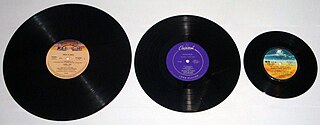
A phonograph record or a vinyl record is an analog sound storage medium in the form of a flat disc with an inscribed, modulated spiral groove. The groove usually starts near the outside edge and ends near the center of the disc. The stored sound information is made audible by playing the record on a phonograph.
RCA Records is an American record label owned by Sony Music Entertainment, a subsidiary of Sony Group Corporation.

Pathé Records was an international record company and label and producer of phonographs, based in France, and active from the 1890s through the 1930s.
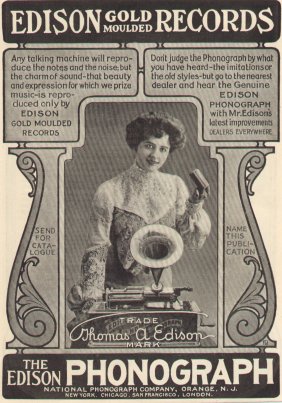
Edison Records was one of the early record labels that pioneered sound recording and reproduction, and was an important and successful company in the early recording industry.

The twelve-inch single is a type of vinyl gramophone record that has wider groove spacing and shorter playing time with a "single" or a few related sound tracks on each surface, compared to LPs which have several songs on each side. It is named for its 12-inch (300 mm) diameter that was intended for LPs. This technical adaptation allows for louder levels to be cut on the disc by the mastering engineer, which in turn gives a wider dynamic range, and thus better sound quality. This record type, which is claimed to have been accidentally discovered by Tom Moulton, is commonly used in disco and dance music genres, where DJs use them to play in clubs. They are played at either 33+1⁄3 or 45 rpm. The conventional 7-inch single usually holds three or four minutes of music at full volume. The 12-inch LP sacrifices volume for extended playing time.
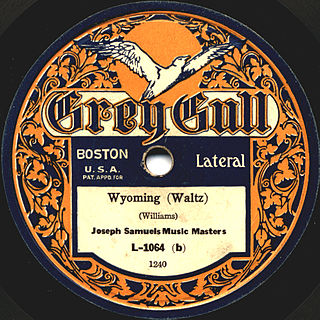
Grey Gull Records was a record company and label founded in Boston, Massachusetts in 1919. The company was started by Theodore Lyman Shaw, a member of an upper class family from Wellesley, Massachusetts.
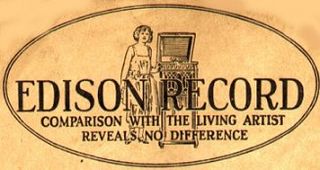
The Edison Diamond Disc Record is a type of phonograph record marketed by Thomas A. Edison, Inc. on their Edison Record label from 1912 to 1929. They were named Diamond Discs because the matching Edison Disc Phonograph was fitted with a permanent conical diamond stylus for playing them. Diamond Discs were incompatible with lateral-groove disc record players, e.g. the Victor Victrola, the disposable steel needles of which would damage them while extracting hardly any sound. Uniquely, they are just under 1⁄4 in thick.

An album is a collection of audio recordings issued on a medium such as compact disc (CD), vinyl (record), audio tape, or digital. Albums of recorded sound were developed in the early 20th century as individual 78 rpm records (78s) collected in a bound book resembling a photo album; this format evolved after 1948 into single vinyl long-playing (LP) records played at 33+1⁄3 rpm.

The overwhelming majority of records manufactured have been of certain sizes, playback speeds, and appearance. However, since the commercial adoption of the gramophone record, a wide variety of records have also been produced that do not fall into these categories, and they have served a variety of purposes.
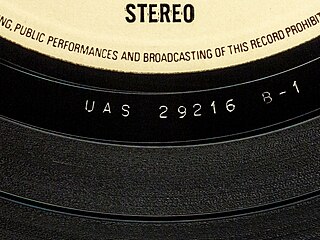
A matrix number is an alphanumeric code stamped or handwritten into the run-out groove area of a phonograph record. This is the non-grooved area between the end of the final band on a record's side and the label, also known as the run-off groove area, end-groove area, matrix area, or "dead wax".

The LP is an analog sound storage medium, specifically a phonograph record format characterized by: a speed of 33+1⁄3 rpm; a 12- or 10-inch diameter; use of the "microgroove" groove specification; and a vinyl composition disk. Introduced by Columbia Records in 1948, it was soon adopted as a new standard by the entire US record industry and, apart from a few relatively minor refinements and the important later addition of stereophonic sound in 1957, it remained the standard format for record albums during a period in popular music known as the album era. LP was originally a trademark of Columbia and competed against the smaller 7-inch sized "45" or "single" format by RCA Victor, eventually ending up on top. Today in the vinyl revival era, a large majority of records are based on the LP format and hence the LP name continues to be in use today to refer to new records.
The AES coarse-groove calibration discs (AES-S001-064) are a boxed set of two identical discs, one for routine use, one for master reference. The intent is to characterize the reproduction chain for the mass transfer of coarse-groove records to digital media, much like using a photographic calibration reference in image work.

Merry Christmas is a Christmas-themed compilation album by Bing Crosby that was released in 1945 on Decca Records. It has remained in print through the vinyl, CD, and downloadable file eras, currently as the disc and digital album White Christmas on MCA Records, a part of the Universal Music Group, and currently on vinyl as Merry Christmas on Geffen Records. It includes Crosby's signature song "White Christmas", the best-selling single of all time with estimated sales of over 50 million copies worldwide. The album was certified 4× Platinum by RIAA for selling over 4 million copies in United States. The original 1945 release and subsequent re-releases and re-packages spent a total of 39 weeks at no. 1 on the Billboard pop albums chart.

Mario Chamlee was one of the lyric tenors who inherited several roles associated with Enrico Caruso at the Metropolitan Opera.

Electrical transcriptions are special phonograph recordings made exclusively for radio broadcasting, which were widely used during the "Golden Age of Radio". They provided material—from station-identification jingles and commercials to full-length programs—for use by local stations, which were affiliates of one of the radio networks.
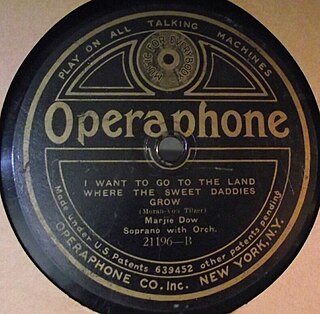
Operaphone Records was a record company in existence from 1915 until 1921, who released numerous phonograph records cut in the hill-and-dale and universal-cut methods.
Domino Records was a United States producer of early phonograph records. The company was originally named Empire Phonograph Corporation, but changed their name to Domino Phonograph Corporation in 1915, apparently before producing any products. The label debuted June 1916. They produced two-sided, 7-inch fine-groove vertical-cut disc records with a light-blue label and dark-blue lettering. Domino advertised their playing time as equal to that of a 10-inch disc. Playing time was actually around two-and-a-half minutes. The discs were marketed by two different companies; out of New York by the W.R. Anderson Company, and out of Dayton, Ohio, by the Thomas Manufacturing Company. Domino Records also made 7-inch pressings for other concerns, including Concert Records, Domestic Records, and Melodograph Records. In February 1917 a 10-inch red disc was introduced by Domino.
The Discography of American Historical Recordings (DAHR) is a database catalog of master recordings made by American record companies during the 78rpm era. The 78rpm era was the time period in which any flat disc records were being played at a speed of 78 revolutions per minute. The DAHR provides some of these original recordings, free of charge, via audio streaming, along with access to the production catalogs of those same companies. DAHR is part of the American Discography Project (ADP), and is funded and operated in partnership by the University of California, Santa Barbara, the National Endowment for the Humanities, and the Packard Humanities Institute.
















